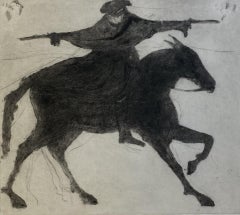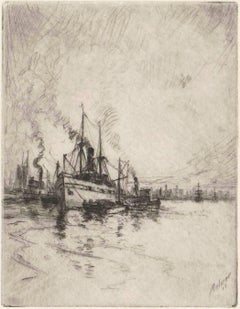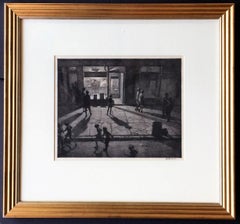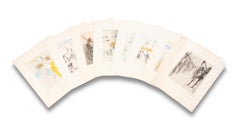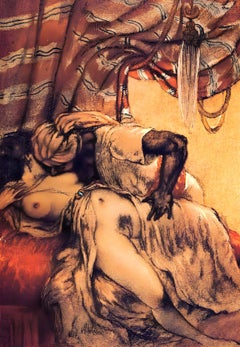Art by Medium: Drypoint
1960s Abstract Art by Medium: Drypoint
Drypoint, Etching
2010s Contemporary Art by Medium: Drypoint
Drypoint
Early 20th Century American Modern Art by Medium: Drypoint
Handmade Paper, Drypoint, Etching
1930s American Modern Art by Medium: Drypoint
Drypoint, Etching
1970s Surrealist Art by Medium: Drypoint
Drypoint, Etching
1930s Modern Art by Medium: Drypoint
Drypoint, Etching
1930s Other Art Style Art by Medium: Drypoint
Drypoint, Etching
1980s American Modern Art by Medium: Drypoint
Drypoint, Etching, Aquatint
1920s Art by Medium: Drypoint
Drypoint, Etching
Early 20th Century French School Art by Medium: Drypoint
Handmade Paper, Drypoint, Etching
1930s Modern Art by Medium: Drypoint
Drypoint, Etching
20th Century Modern Art by Medium: Drypoint
Drypoint, Etching
1920s Expressionist Art by Medium: Drypoint
Drypoint, Etching, Aquatint
1960s Abstract Art by Medium: Drypoint
Drypoint, Etching
1920s American Modern Art by Medium: Drypoint
Drypoint, Etching
Early 20th Century American Modern Art by Medium: Drypoint
Laid Paper, Drypoint, Etching
1960s Cubist Art by Medium: Drypoint
Drypoint, Etching, Aquatint
17th Century Old Masters Art by Medium: Drypoint
Drypoint, Etching
1960s Surrealist Art by Medium: Drypoint
Drypoint
1980s Abstract Expressionist Art by Medium: Drypoint
Archival Paper, Drypoint, Aquatint
1850s Art by Medium: Drypoint
Drypoint, Etching
1920s American Modern Art by Medium: Drypoint
Drypoint, Etching
Mid-20th Century Abstract Art by Medium: Drypoint
Drypoint, Etching
Early 20th Century Modern Art by Medium: Drypoint
Laid Paper, Drypoint, Etching
1970s Art by Medium: Drypoint
Drypoint
1970s Surrealist Art by Medium: Drypoint
Drypoint
1970s Surrealist Art by Medium: Drypoint
Mixed Media, Lithograph, Drypoint, Screen
1930s Modern Art by Medium: Drypoint
Drypoint, Etching
1930s Art by Medium: Drypoint
Drypoint
Early 20th Century Modern Art by Medium: Drypoint
Drypoint, Etching, Aquatint
1970s Surrealist Art by Medium: Drypoint
Drypoint, Etching
1920s Realist Art by Medium: Drypoint
Engraving, Drypoint
Early 20th Century French School Art by Medium: Drypoint
Handmade Paper, Drypoint, Etching
1930s Modern Art by Medium: Drypoint
Drypoint, Etching
1930s Modern Art by Medium: Drypoint
Drypoint, Etching
1930s American Modern Art by Medium: Drypoint
Drypoint
Early 1900s Post-Impressionist Art by Medium: Drypoint
Drypoint, Etching
1930s Impressionist Art by Medium: Drypoint
Paper, Drypoint, Lithograph
1930s Modern Art by Medium: Drypoint
Drypoint, Etching
20th Century Abstract Art by Medium: Drypoint
Drypoint, Etching
1920s American Modern Art by Medium: Drypoint
Drypoint, Etching
Early 2000s Pop Art Art by Medium: Drypoint
Oil Crayon, Drypoint, Etching, Offset
20th Century American Modern Art by Medium: Drypoint
Drypoint, Etching
1940s American Modern Art by Medium: Drypoint
Drypoint
Early 20th Century American Modern Art by Medium: Drypoint
Archival Paper, Drypoint, Etching
1880s Impressionist Art by Medium: Drypoint
Drypoint, Etching
Early 1900s Expressionist Art by Medium: Drypoint
Drypoint
1930s Modern Art by Medium: Drypoint
Drypoint, Etching
Early 19th Century Realist Art by Medium: Drypoint
Laid Paper, Drypoint, Etching
1960s Surrealist Art by Medium: Drypoint
Engraving, Drypoint
1920s Modern Art by Medium: Drypoint
Drypoint, Etching
Early 18th Century Old Masters Art by Medium: Drypoint
Etching, Engraving, Drypoint
1920s American Impressionist Art by Medium: Drypoint
Drypoint
21st Century and Contemporary Contemporary Art by Medium: Drypoint
Archival Paper, Color, Etching, Intaglio, Drypoint, Aquatint
1880s Modern Art by Medium: Drypoint
Drypoint, Etching
1970s Surrealist Art by Medium: Drypoint
Drypoint
1960s Abstract Art by Medium: Drypoint
Drypoint, Etching, Aquatint
1920s Impressionist Art by Medium: Drypoint
Drypoint, Etching
Early 2000s Contemporary Art by Medium: Drypoint
Paper, Drypoint
1910s Art by Medium: Drypoint
Woodcut, Drypoint
